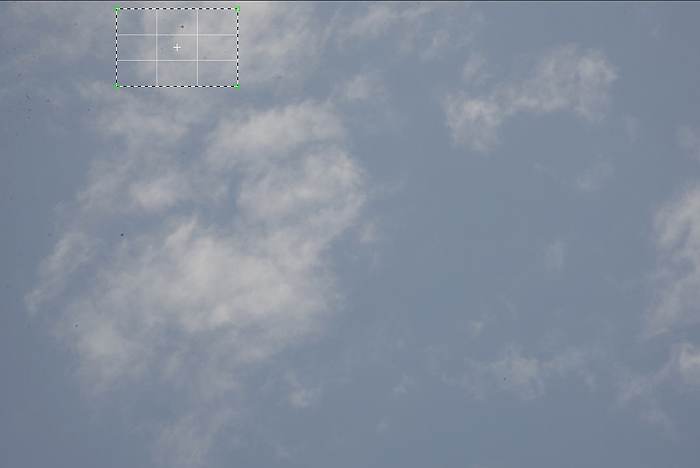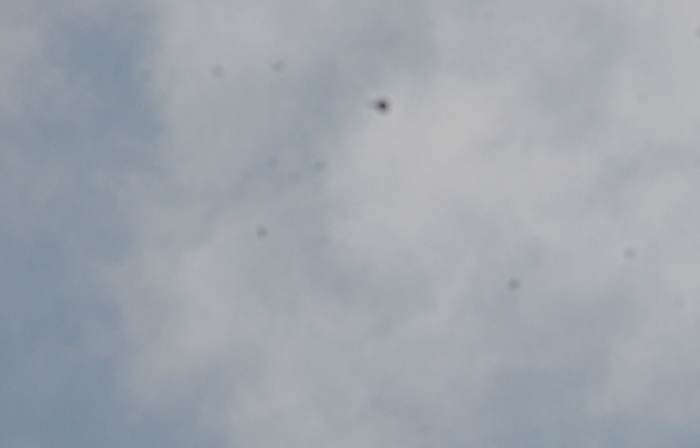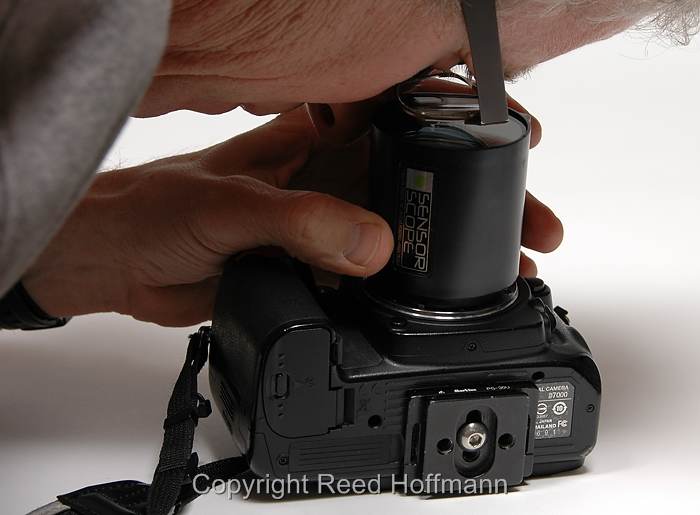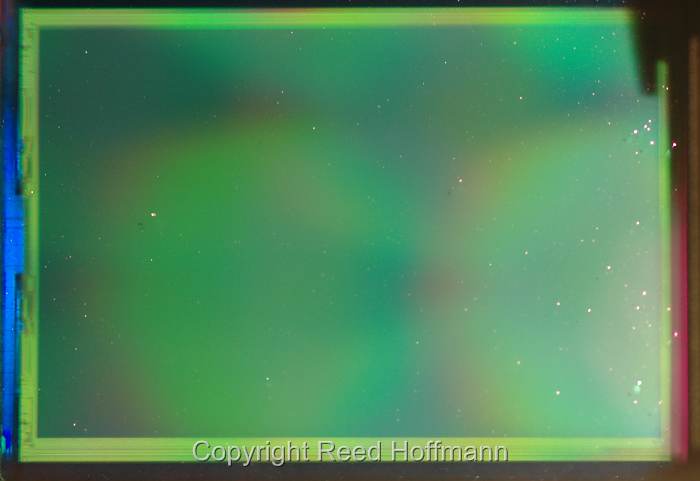I just finished doing something I really hate doing. I cleaned the sensors of a couple of my cameras. If you have a digital camera and can change lenses, at some point you’re going to have dust on that sensor, which can create problems. Fortunately, there are solutions for both minimizing and solving these problems.
Dust gets into your camera various ways. The most common is while changing lenses. Which is a great reason to be careful. Change as little as possible in dirty, windy environments. When you have to, shield the camera body from the wind as much as possible, and do it quickly. And

Full frame view, the area enlarged to show the dust (photo at top) is shown by the rectangle in the upper left corner of the frame. Photo copyright Reed Hoffmann.
never leave a camera sitting around without a lens or body cap. Don’t forget that anything inside a rear lens cap or body cap (dust, lint, etc.) can end up inside your camera. Blow them off (with your mouth) before putting them on your lenses or bodies.
Even if you rarely change lenses, you can get dust inside the camera simply by zooming the lens. Since elements inside the camera have to shift forward and backward to do that, there has to be some exchange of air.
How can you tell if there’s dust on your sensor? It’s most easily seen in featureless areas, like blue or gray skies, when shooting at small apertures (like f/16 or smaller). It appears as small blurry spots. If you haven’t noticed a dust problem and want to see if you have any, photograph the sky at the smallest aperture possible. If you see a lot of spots, or some large ones that appear regularly in your pictures, then it’s time to get rid of them. However, it’s always worth mentioning that if you’ve not noticed a dust problem, it’s probably not worth worrying about right now.

Close-up view showing how bad the dust is on this sensor. Photo copyright Reed Hoffmann.
Cleaning sensors breaks down into three general types. Many cameras have a “clean sensor” function built into them. This doesn’t actually clean the sensor, but shakes the low-pass filter covering the sensor (where the dust would be) to try to dislodge any dust that’s recently settled on it. This is fairly effective, but more aggressive techniques are sometimes needed.
The second simple way to clean a sensor is to blow it off with a bulb blower. To do this, you first have to get the mirror and shutter out of the way (that’s if you have an SLR). Some manufacturers, like Nikon, offer a “Lock mirror up for cleaning” option in the Setup menu. To use this the battery needs to be fully charged, and when engaged locks the mirror in the up position and the shutter open. To unlock, turn the camera off. If your camera doesn’t have a feature like this, then simply put it in “Bulb” mode and press and hold down the shutter button. When you do this the mirror and shutter will stay in the open position until you release the shutter. However you do it, once the mirror and shutter are open, you can then give a few good puffs with the bulb blower to try to knock any dust from the sensor. I hold the camera face down, so that stuff will fall out of the camera, not into it. Remember to never put the tip of the bulb blower inside the body of the camera. There are a lot of delicate, easily damaged parts in there. Blowing off the sensor is good preventative maintenance, and done regularly will lessen the need to have to physically clean it.

Using a sensor loupe to inspect a sensor for dust.Photo copyright Reed Hoffmann.
The third, and most difficult method of cleaning the sensor is to actually wipe it with some type of swab and liquid. This is the one I hate doing. It means you’re physically touching the sensor (actually the filter over the sensor), and there’s a real risk of damage. If you don’t do it carefully, and right, with the correct materials, you can actually make things worse. Not for the faint-hearted. Having said that, there are a lot of photographers who have bought the gear and do this on a regular basis. There are several companies that make this equipment, among the best known is Visible Dust. Delkin and others also sell kits. There are also magnifying loupes you can buy with built-in lights to get a better look at the sensor. If you get one you’ll be amazed at how much junk is there. And even if you do a good,

Magnified view of a sensor, showing dust spots on it. Photo copyright Reed Hoffmann.
thorough cleaning, odds are you’ll still see some dust. A good cleaning will remove the worst of it, and hopefully any spots that remain will be small enough to not be a problem.
If you don’t want to clean the sensor yourself, many camera stores offer this service for a reasonable price. And you manufacture probably offers what Nikon calls a “Clean and Check” where in addition to cleaning the sensor, they check that everything’s working properly and the firmware is up to date.
Of course, the best option is not needing to physically clean the sensor. Taking care when

Carefully cleaning the sensor with a special brush that had a few drops of cleaning fluid applied to it. Photo copyright Reed Hoffmann.
changing lenses, and regularly blowing off any dust that might be there (once a month?) is great preventive maintenance. And if you get dust spots, most software today has good tools for removing it from your image.
All in all, I’ll take dust over the scratched film and sprocket streaks (from processing) that we used to have. As with most aspects of digital photography, I find the benefits outweigh what few drawbacks there are now. Dust is just a fact of our new photographic lives. Understand how to deal with it and move on.

